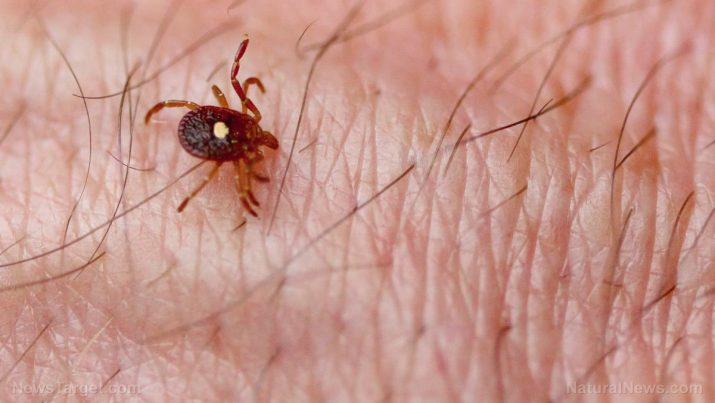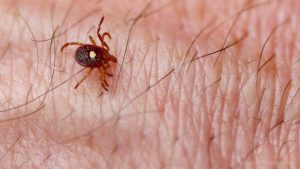
Rocky Mountain spotted fever – causes, side effects and treatments at NaturalPedia.com
Tuesday, June 19, 2018 by Zoey Sky
http://www.naturalpedia.com/rocky-mountain-spotted-fever-causes-side-effects-and-treatments-at-naturalpedia-com.html

Rocky Mountain spotted fever (RMSF) is a disease that was first identified in the Rocky Mountain states. The disease is caused by Rickettsia rickettsii and is transmitted by ixodid (hard-shelled) ticks.
RMSF only occurs in the Western Hemisphere. Side effects of the disease include high fever and a rash.
Edward Ernest Maxey, an ear, nose, and throat specialist, was the first person to describe the disease in 1899. n 1906, Howard Taylor Ricketts, a pathologist, confirmed that RMSF was transmitted by a tick bite. Rickettsia rickettsii, the agent that causes the disease, was named after him.
Rocky Mountain spotted fever is also known as spotted fever, tick fever, and tick typhus.

Known side effects of Rocky Mountain spotted fever
While the early side effects of RMSF are not specific to the disease, such as fever and headache, it can quickly develop into a severe and life-threatening illness.
The side effects of RMSF may include:
- Fever
- Headaches
- Lack of appetite
- Muscle pain
- Nausea
- Rash
- Stomach pain
- Vomiting
Most patients with the disease experience a rash that often develops about two to four days after the fever begins. The appearance of the rash may vary over the course of illness. Some rashes appear as red splotches while others look like pinpoint dots.
Even though most individuals with RMSF will develop a rash, it usually doesn’t appear within the first few days of illness, making the disease hard to diagnose.
Frequenting tick-infested areas, such as Arkansas, Missouri, North Carolina, Oklahoma, and Tennessee, can increase an individual’s risk for developing RMSF.
Body systems harmed by Rocky Mountain spotted fever
If left untreated, RMSF may cause the following complications:
- Brain damage
- Clotting problems
- Heart failure
- Kidney failure
- Lung failure
- Meningitis
- Pneumonitis/lung inflammation
- Shock
Food items or nutrients that may prevent Rocky Mountain spotted fever
The best way to prevent RMSF is to follow certain guidelines, such as wearing appropriate clothing outdoors. Wear light-colored clothing so it’s easier to spot ticks. Wear long-sleeved shirts tucked into pants, long pants with legs tucked into socks, and closed-toe shoes.
Always do a thorough check for ticks all over your body:
- Around the joints – Check behind the knees, between the fingers and toes, underarms, and the groin.
- Other areas where ticks are usually found – The belly button, in and behind the ears, the hairline, neck, and the top of the head.
- Areas of pressure points – Such as anywhere that clothing presses tightly on the skin.
- All other areas of the body or the hair – Run your fingers over your skin and use a fine-toothed comb on your hair to check for ticks.
Try to use cleared paths and pavement when walking through wooded areas and fields. Always shower after participating in outdoor activities. Ticks can take at least four to six hours to attach firmly to the skin and showering can help remove any loose ticks. Don’t forget to check pets for ticks and treat as needed.
Treatments, management plans for Rocky Mountain spotted fever
To prevent RMSF, carefully remove any ticks from the skin.
To treat infections, patients are administered antibiotics (e.g., doxycycline or tetracycline). Pregnant women may be advised to take chloramphenicol.
Where to learn more
- Antioxidants may protect against tick-borne illness (press release)
- Do Not Kill a Fever: Fever Kills Viruses
- New hardy tick infesting New Jersey expected to migrate westward, experts warn the public to be extra careful
- Revolutionary diagnosis: A single blood test can now detect Lyme and other tick-borne diseases
- Vitamin C proven to cure over 30 major diseases
Summary
Rocky Mountain spotted fever (RMSF) is a bacterial disease first identified in the Rocky Mountain states. The disease is caused by Rickettsia rickettsii that’s transmitted by ixodid (hard-shelled) ticks.
While the early side effects of RMSF are not specific to the disease, such as fever and headache, it can quickly develop into a severe and life-threatening illness.
If left untreated, RMSF may cause complications like brain damage, clotting problems, and heart failure.
The best way to prevent RMSF is to follow certain guidelines, such as wearing appropriate clothing outdoors.
To prevent RMSF, carefully remove any ticks from the skin.
Sources include:
Tagged Under: Tags: Rocky Mountain spotted fever





